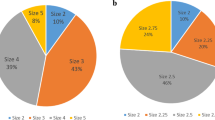Abstract
Introduction and hypothesis
In this study, the impact of mid-urethral slings (MUS) on incontinence-related distress, quality of life and sexual function is assessed at a minimum 2 years.
Methods
Patients received either a pubovaginal sling (PVS) or a tension-free vaginal tape (TVT). The Arabic translation of urogenital distress inventory (UDI)-6, incontinence impact questionnaire (IIQ)-7, and short form Female Sexual Function Index (FSFI) were administered at baseline and 24 months.
Results
Sixty three women with a mean age of 47.8 years were included in this study. A median follow-up was done after 54 ± 21.9 months. Thirty nine women had PVS while 24 had TVT. Cure was defined as a significant decrease in UDI-6 and a negative stress test at 200 ml, which was found to be 93.65% and 95.2%, respectively. Overall, UDI-6 decreased from a mean preoperative value of 68.1 ± 16.9 to 27.6 ± 18.3 (p < 0.0001). IIQ-7 decreased from 70 ± 19 to 24 ± 20.8(p < 0.0001). The difference between pre- and postoperative values was insignificant.
Conclusion
An MUS gives a cure rate of over 93% at a median follow-up of 54 months. A significant decline in UDI-6 and IIQ-7 is evident after surgery. Sexual function, as measured by the FSFI, was not significantly affected.
Similar content being viewed by others
Abbreviations
- BMI:
-
Body mass index
- HPF:
-
High-power field
- FSFI:
-
Female Sexual Function Index
- IIQ:
-
Incontinence Impact Questionnaire
- MMK:
-
Marshall–Marchetti–Krantz
- MUS:
-
Mid-urethral sling
- PVS:
-
Pubovaginal sling
- RCT:
-
Randomized controlled trial
- SUI:
-
Stress urinary incontinence
- SISTEr:
-
Stress Incontinence Surgical Treatment Efficacy Trial
- TVT:
-
Tension-free vaginal tape
- UDI:
-
Urogenital distress inventory
- UTI:
-
Urinary tract infection
References
Gilleran JP, Zimmern P (2005) An evidence-based approach to the evaluation and management of stress incontinence in women. Curr Opin Urol 15:236–243
Morgan TO, Westney OL, McGuire EJ (2000) Pubovaginal sling: 4-year outcome analysis and quality of life assessment. J Urol 163:1845–1848
Lee KS, Choo KS, Doo CK, Hanm DH, Lee YS, Kim WS, Jung HC (2008) The long term (5-years) objective TVT success rate does not depend on predictive factors at multivariate analysis: a multicenter prospective study. Eur Urol 53:76–182
Uebersax JS, Wyman JF, Shumaker SA, McClish DD, Fantl JA, and the continence program for women research group (1995) Short forms to assess life quality and symptom distress for urinary incontinence in women: the Incontinence Impact Questionnaire and Urogenital Distress Inventory. Neurourol Urodyn 14:131–139
Wadie BS, Edwan A, Nabeeh A (2005) Autologous fascial sling versus polypropylene tape at short-term follow-up, a prospective randomized study. J Urol 174:990–993
Sung VW, Schleinitz MD, Rardin CR, Ward RM, Myers DL (2007) Comparison of retropubic vs transobturator approach to mid urethral slings: a systematic review ad meta-analysis. Am J Obstet Gynecol 197:3–11
Tennstedt SL, Litman HJ, Zimmern P, Ghetti C, Kusek JW, Nager CW, Mueller ER, Kraus SR, Varner E, and the Urinary Incontinence Treatment Network (2008) Quality of life after surgery for stress incontinence. Int Urogynecol J 19:1631–1638
Hullfish K, Bovborg V, Steers W (2004) Patient-centered goals for pelvic floor dysfunction surgery: long-term follow-up. Am J Ob Gyn 24:606–610
Morgan DM, Dunn RL, Fenner DE, Faerber G, De Lancey JO, McGuire EJ, Wei JT (2007) Comparative analysis of urinary incontinence severity after autologous fascia pubovaginal sling, pubovaginal sling and tension free vaginal tape. J Urol 177:604–608
Rutman M, Itano N, Deng D, Raz S, Rodriguez L (2006) Long term durability of the distal urethral polypropylene sling procedure for stress incontinence: minimum 5-year followup of surgical outcome and satisfaction determined by patient reported questionnaires. J Urol 175:610–613
Nilsson CG, Palva K, Rzapour M, Falconer C (2008) Eleven years prospective follow-up of the tension-free vaginal tape for treatment of stress urinary incontinence. Int Urogynecol J Pelvic Floor Dysfunct 19:1043–1047
Nazemi TM, Yamada B, Govier FE, Kuznetsov DD, Kodama K, Kobashi KC (2008) Minimum 24-month followup for the treatment of stress urinary incontinence. J Urol 179:596–599
Langford CF, Elissiry MM, Ghoneim GM (2008) Do women have realistic expectations of treatment for stress urinary incontinence? Neurourol Urodyn 27:480–484
Albo ME, Richter HE, Brubaker L, Norton P, Kraus SR, Zimmern PE, and the Urinary Incontinence Treatment Network et al (2007) Burch colposuspension versus fascial sling to reduce urinary stress incontinence. N Eng J Med 356:2143–55
Tunuguntla HSGR, Gousse AE (2006) Female sexual dysfunction following vaginal surgery: a review. J Urol 175:439–446
Hassouna ME, Ghoniem GM (1999) Long-term outcome and quality of life after modified pubovaginal sling for intrinsic sphincter deficiency. Urology 53:287–291
Sentilhes L, Berthier A, Caremel R, Loisel C, Marpeau L, Grise P (2008) Sexual function after transobturator tape procedure for stress urinary incontinence. Urology 71:1074–1079
Murphy M, van Raalte H, Mercurio E, Haff R, Wiseman B, Lucente VR (2008) Incontinence-related quality of life and sexual function following the tension-free vaginal tape versus the “inside-out” tension-free vaginal tape obturator. Int Urogynecol J 19:481–487
Kim DY, Choi JD (2008) Change of sexual function after mid-urethral sling procedure for stress urinary incontinence. Int J Urol 15:716–719
Martan A, Svab K, Masata J, Koleska T, El-Haddad R, Pavlikova M (2009) Initial experience with a short, tension-free vaginal tape (the tension-free vaginal tape secur system). Euro J Obstet Gynecol Rep Bio 143:121–125
Latthe PM (2008) Review of transobturator and retropubic tape procedures for stress urinary incontinence. Curr Opin Obstet Gynecol 20:331–6
Conflicts of interest
None.
Author information
Authors and Affiliations
Corresponding author
Rights and permissions
About this article
Cite this article
Wadie, B.S., Mansour, A., El-Hefnawy, A.S. et al. Minimum 2-year follow-up of mid-urethral slings, effect on quality of life, incontinence impact and sexual function. Int Urogynecol J 21, 1485–1490 (2010). https://doi.org/10.1007/s00192-010-1216-z
Received:
Accepted:
Published:
Issue Date:
DOI: https://doi.org/10.1007/s00192-010-1216-z




